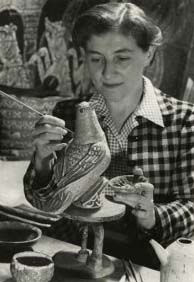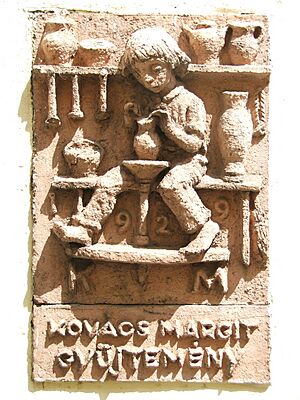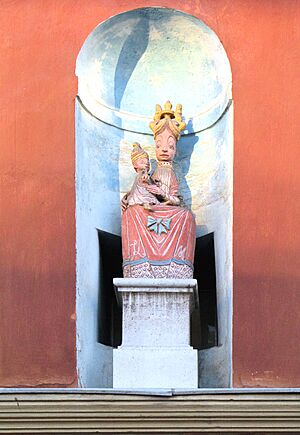Margit Kovács facts for kids
Quick facts for kids
Margit Kovács
|
|
|---|---|
 |
|
| Born | November 30, 1902 Győr, Hungary
|
| Died | June 4, 1977 (aged 74) Budapest, Hungary
|
| Nationality | Hungarian |
| Education | State School of Applied Arts, Munich |
| Known for | Ceramics |
Margit Kovács (1902–1977) was a famous Hungarian artist. She was known for creating beautiful art using clay and for making sculptures. Her work is still loved and displayed today.
Contents
Margit Kovács: A Hungarian Artist
Her Early Life and Training
Margit Kovács was born in Győr, Hungary, on November 30, 1902. When she was young, she wanted to be a graphic artist. This means she wanted to create drawings and prints.
But in the 1920s, she became very interested in ceramics. Ceramics is the art of making things from clay and then baking them. She decided to study this art form.
From 1926 to 1928, Margit studied in Vienna with Hertha Bücher. Hertha was a well-known Austrian ceramic artist. After that, Margit went to Munich to study clay modeling. She learned at the State School of Applied Arts from 1928 to 1929. There, she became lifelong friends with Julia Bathory, who was a glass artist.
Margit continued to learn and improve her skills. She studied in Copenhagen in 1932. In 1933, she went to the Sèvres Porcelain factory in France. Here, she became an expert at working with a special type of clay called chamotte to create figures.
Awards and Recognition
Margit Kovács became very successful. She won many international awards for her art. These awards came from cities like Milan, Paris, Berlin, Brussels, and Rome.
She was also very popular in Hungary. She received many requests to create art for public places. In 1959, the government gave her the "Distinguished Artist Award." This was a high honor for her artistic achievements.
What She Created
Margit Kovács had her first public art show in Budapest in 1928. From then on, she made a lot of art. She kept working even during the Second World War.
Her art included many different things. She made small statues, pots, plates, and wall plaques. She also created large tiled murals, which are artworks made of many small tiles on a wall.
Her main ideas for her art often came from everyday life. She showed country people, family scenes, and stories from the Bible. Her art was very diverse, but it always had smooth, flowing lines. These lines helped to show feelings and emotions in her work.
One of her most important religious artworks is the entrance of the Saint Emeric Church in Győr. She created this between 1939 and 1940.
Many of her ceramic murals can still be seen in Budapest and other cities. These large artworks are a big part of her legacy.
Her Legacy
In 1972, Margit Kovács gave most of her artworks to the Pest County Museums Directorate. This was a big gift that helped preserve her art.
A museum dedicated to her work opened in 1973 in Szentendre, Hungary. It is called the Margit Kovács Museum. There is also a collection of her art in Győr, her hometown.
Death
Margit Kovács passed away in Budapest on June 4, 1977. She is buried in the Farkasréti Cemetery in Budapest. Her art continues to inspire people today.
Images for kids
See also
 In Spanish: Margit Kovács para niños
In Spanish: Margit Kovács para niños






